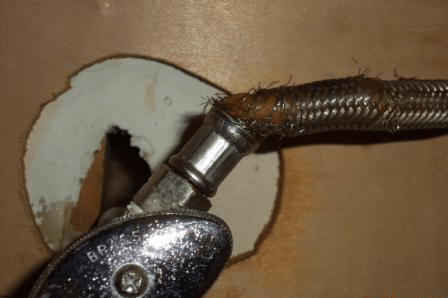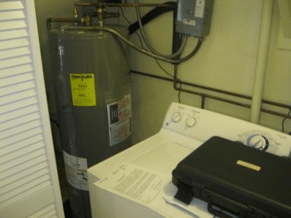Over the past few months, we have had a large number of customers experiencing hot water tank and appliance overflows resulting in expensive water damage. Unfortunately, it's an upsetting story that we hear too often - bubbles overflowing onto the laundry room floor like in a bad sitcom episode. But the end result is no joke - rooms and contents flooded with water. The water often travels down several floors, damaging ceilings, flooring, and walls. And even a small leak, if not addressed immediately, can lead to long-term damage and mold growth.
Water damage is never a welcome event and according to a study done by the Insurance Institute for Business & Home Safety (IBHS) the top five leading causes of homeowner water damage included water heater failure and washing machine failure with an average claim size of $5,000. The most common issue with a washing machine is a broken hose, which can leak up to 600 gallons an hour if not stopped. Often caused by long-term wear or poor hose quality, the water supply hose is to blame in over half of all washing machine water events.
So we thought it might be helpful to point out ways that you can prevent water damage from appliances and keep your home safe and dry.
Water Heater Failure
The most common causes of water heater failures in the IBHS study were a slow leak or a sudden burst in the tank, followed by supply line failures. The chance a water heater will leak or burst begins to dramatically increase when it is 5 years old. In fact, 3/4 of all water heaters fail before they are 12 years old.
Loss Prevention & Maintenance Tips
- Check life expectancy and warranty for the water heater and replace accordingly.
- Proper maintenance, such as flushing sediments every six months and inspecting the heater's anode rod, can increase life expectancy. Sediment will build up faster in areas with hard water.
- Inspect valves to ensure proper operations, and use ball valves in place of gate valves whenever possible.
- Have a professional plumbing inspection of the anode rod at least once every 2 years and annually once the warranty has expired. The rod will eventually corrode and leave the tank vulnerable to damage.

Washing Machine Failure
More than half of the claims in the IBHS study were linked to washing machine hoses or water supply line failures. Washing machine claims in the study averaged more than $5,300 per incident after the deductible was paid.
Loss Prevention & Maintenance Tips
- Don't try to cut corners by overloading the machine, and use it only while someone is at home.
- One burst inlet hose and your laundry room are flooded in a matter of minutes. Replace rubber hoses every three years and consider upgrading to sturdier braided steel hoses. Check the hoses for cracks, kinks, or blisters, which are most commonly found near the hose connection.
- Consider installing a lever-type valve that is easy to operate between uses.
- Ensure that the connection to the valve is secure, but avoid over-tightening.
- Leave a 3 to 4-inch gap between the back of the washing machine and the wall to avoid kinking the hose near the valve connection.
- Inspect the water supply line hoses every 6 months.
- When leaving the house for an extended period of time, turn off the hot and cold water supply valves to reduce failure risks.

We hope that you find these tips helpful to prevent an appliance overflow at your house. But if you do experience an appliance water damage incident, please call the experts at ServiceMaster Dynamic Cleaning. Our trained technicians are on call 24 hours a day, 7 days a week, to provide fast, efficient remediation services to fix the damage and get you back to normal. Call (800) 865-5157 or Contact Us Now and let our experience work for you!

